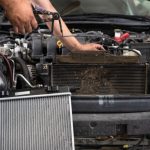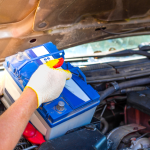The deep, resonant rumble of a V8 engine is a sound that evokes images of power, performance, and a thrilling driving experience. But what exactly lies beneath the hood of a car powered by this iconic engine configuration? In this comprehensive exploration, we’ll embark on a journey to uncover the intricacies of the V8 engine, tracing its historical roots, delving into its design and mechanics, and understanding why it continues to hold a place of distinction in the automotive world.
Understanding the V8 Engine Configuration

At its core, a V8 engine is an eight-cylinder piston engine where the cylinders are arranged in two banks of four, creating a “V” shape when viewed from the end. These cylinders share a common crankshaft, a crucial component that converts the linear motion of the pistons into rotational force, ultimately propelling the vehicle forward. This distinctive “V” configuration is not merely an aesthetic design; it’s a carefully engineered arrangement that provides a harmonious balance of power, smoothness, and efficiency, making it a preferred choice for a diverse range of vehicles, from powerful muscle cars and agile sports cars to robust trucks and spacious SUVs.
A Journey Through History: The Evolution of the V8 Engine
The story of the V8 engine begins in the early 20th century, with its origins intertwined with the nascent fields of aviation and motorsports. One of the earliest known V8 engines was conceived by Léon Levavasseur in 1902, designed to power aircraft and speedboats. The engine’s compact form and impressive power output quickly caught the eye of automobile manufacturers, eager to harness its potential for their own creations. Cadillac emerged as a pioneer in the automotive world by introducing the first mass-produced V8 engine in a passenger car in 1914. This marked a pivotal moment in automotive history, as the V8 engine offered a significant leap in power and performance compared to the inline engines that dominated the era.
Throughout the 20th century, the V8 engine continued its evolutionary journey, driven by relentless innovation and advancements in technology and design. These advancements led to remarkable gains in power, efficiency, and reliability, solidifying the V8’s status as a symbol of automotive prowess. From the roaring muscle cars of the 1960s and 70s to the sophisticated sports cars and luxury sedans of today, the V8 engine has left an indelible mark on the automotive landscape.
The Mechanics of Power: How a V8 Engine Works
To truly appreciate the allure of the V8 engine, we must delve into its inner workings, understanding the carefully choreographed dance of mechanical components that transforms fuel into motion. Like all internal combustion engines, the V8 operates on the four-stroke cycle: intake, compression, power, and exhaust. This cycle is the heart of the engine’s operation, a continuous process of drawing in air and fuel, compressing the mixture, igniting it to generate power, and expelling the exhaust gases.
The intake stroke begins with the downward movement of the piston, creating a vacuum that draws in a precisely measured mixture of air and fuel through the intake valve. As the piston reverses direction and moves upward, the intake valve closes, trapping the mixture within the cylinder. The upward movement of the piston compresses the air-fuel mixture, preparing it for the pivotal moment of ignition. At the peak of compression, the spark plug ignites the mixture, triggering a controlled explosion that forces the piston downward with tremendous force.
This downward thrust is the power stroke, the driving force that sets the crankshaft in motion. Finally, as the piston ascends once again, the exhaust valve opens, allowing the burnt gases to escape, completing the cycle and preparing the cylinder for the next intake. This intricate process unfolds in a precisely timed sequence across all eight cylinders, with each cylinder firing at a specific interval to ensure a smooth and continuous delivery of power.
The Advantages of V8 Engines: A Winning Combination
The enduring popularity of V8 engines can be attributed to a compelling combination of advantages that set them apart in the automotive world. Their ability to generate substantial power stems from the coordinated effort of eight cylinders working in harmony, making them ideally suited for applications where high performance is paramount. The inherent balance of the “V” configuration ensures smooth operation, minimizing unwanted vibrations and providing a refined driving experience.
Despite their power output, V8 engines maintain a relatively compact size, allowing them to be seamlessly integrated into a variety of vehicle platforms. This adaptability extends to a wide range of applications, from powering heavy-duty trucks to propelling high-performance sports cars, showcasing the versatility of this engine configuration. And let’s not forget the distinctive sound – the throaty rumble that has become synonymous with power and performance, adding to the emotional appeal of vehicles equipped with V8 engines.
The V8 Engine in the Modern Era: Adapting to Change
In the face of a rapidly evolving automotive landscape, where fuel efficiency and environmental concerns are taking center stage, the V8 engine is adapting to meet the challenges of the modern era. While electric vehicles and alternative powertrain technologies are gaining momentum, the V8 engine is not fading into obscurity. Advancements in engine technology, such as direct fuel injection, cylinder deactivation, and turbocharging, are enabling manufacturers to extract even more power from smaller displacement V8 engines while simultaneously improving fuel efficiency.
This continuous drive for innovation ensures that the V8 engine remains relevant and competitive in a world increasingly focused on sustainability. Moreover, the V8 engine continues to be the preferred choice for applications where high towing capacity and heavy-duty performance are essential, such as in trucks and large SUVs. In these demanding scenarios, the V8’s ability to deliver robust power and torque remains unmatched, solidifying its position as a workhorse in the automotive world.
The Future of the V8 Engine: A Legacy Endures
As the automotive industry charts a course towards an electrified future, the V8 engine is likely to remain a significant force in the near future. Its inherent advantages in power delivery, performance, and adaptability, coupled with ongoing advancements in engine technology, ensure that the V8 engine will continue to power a diverse range of vehicles, from exhilarating sports cars to dependable workhorses. Whether it’s the soul-stirring roar of a classic muscle car or the refined power of a modern luxury sedan, the V8 engine holds a special place in the hearts of automotive enthusiasts, and its legacy of power and performance is poised to endure, even as the industry embraces new and innovative technologies.











